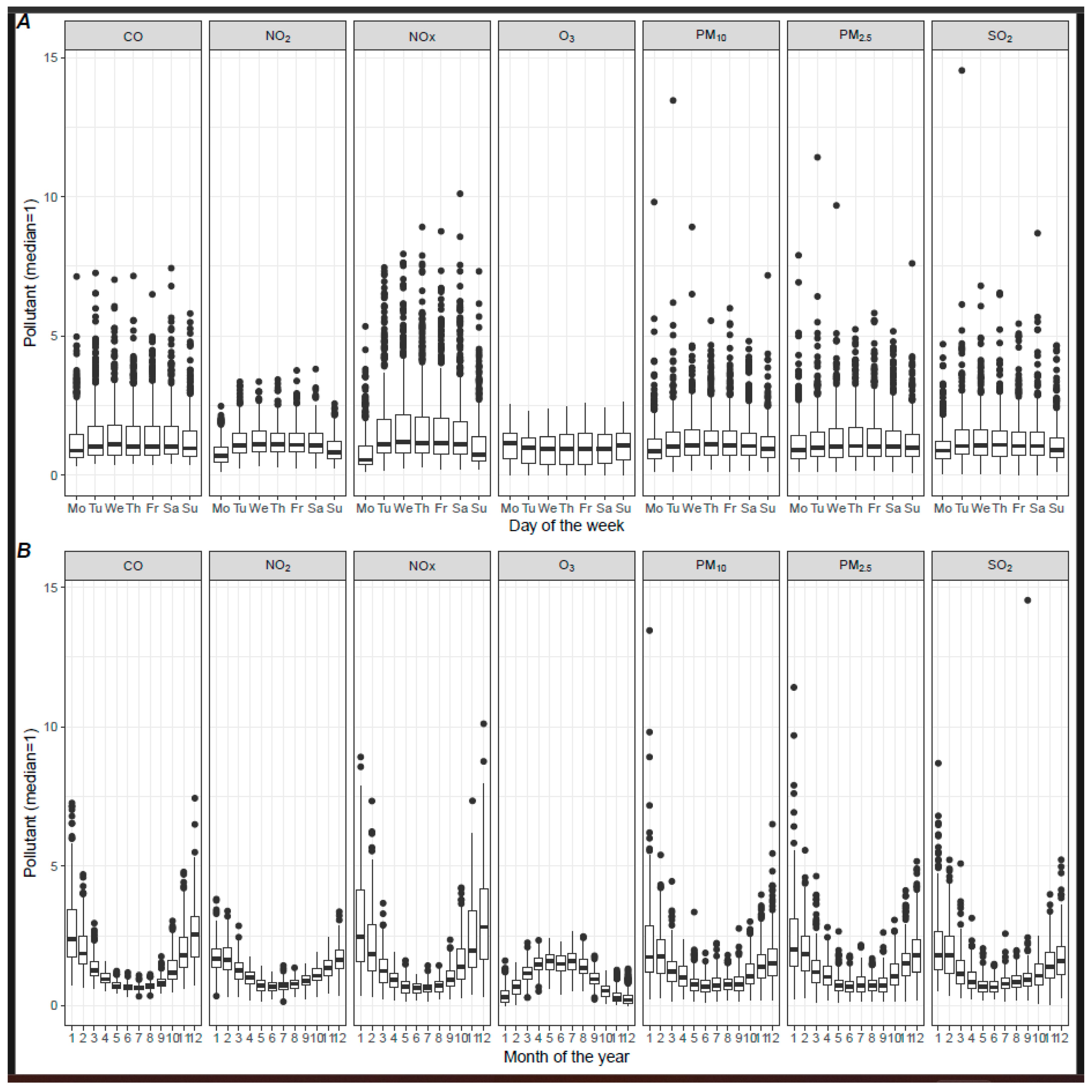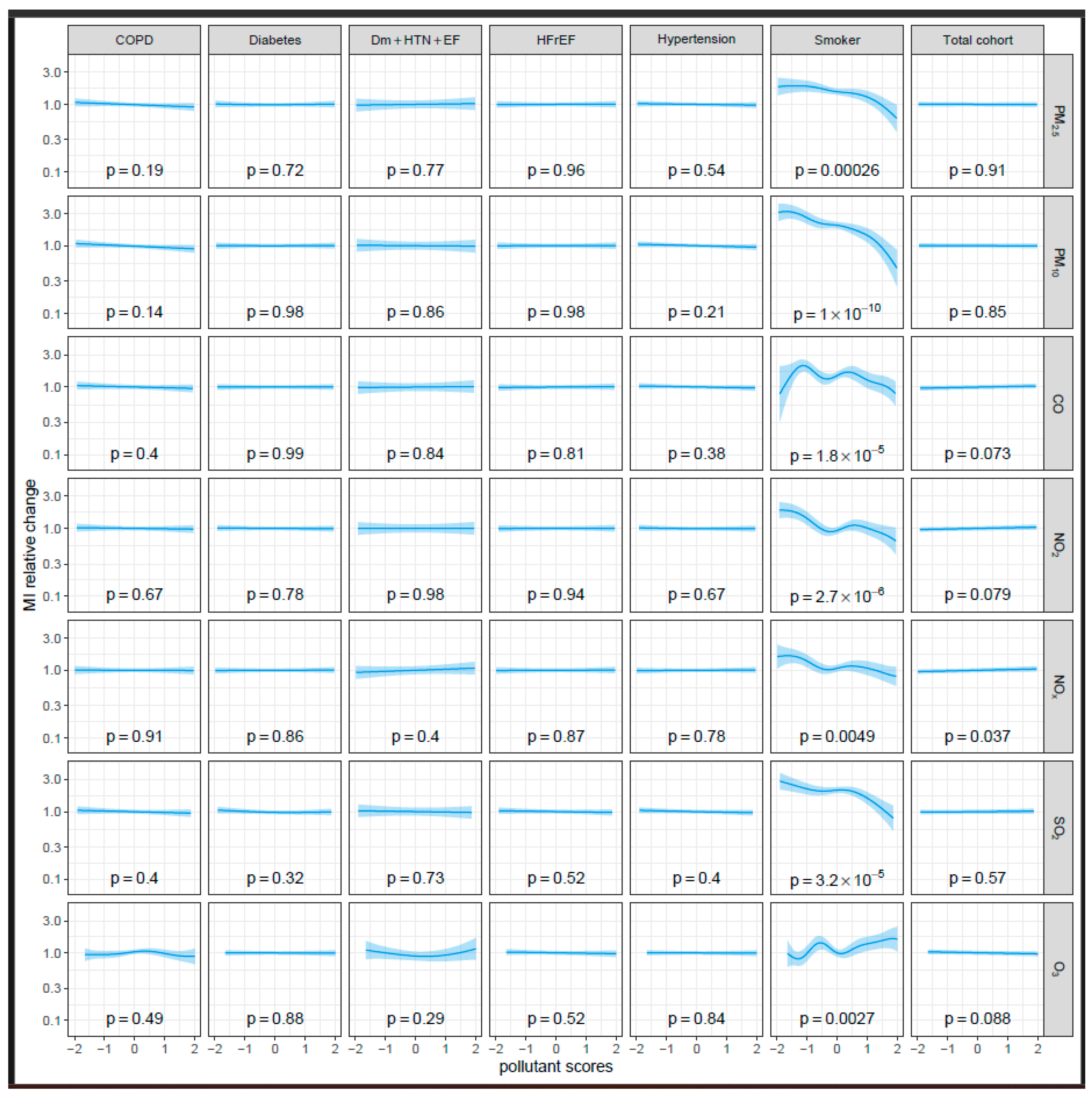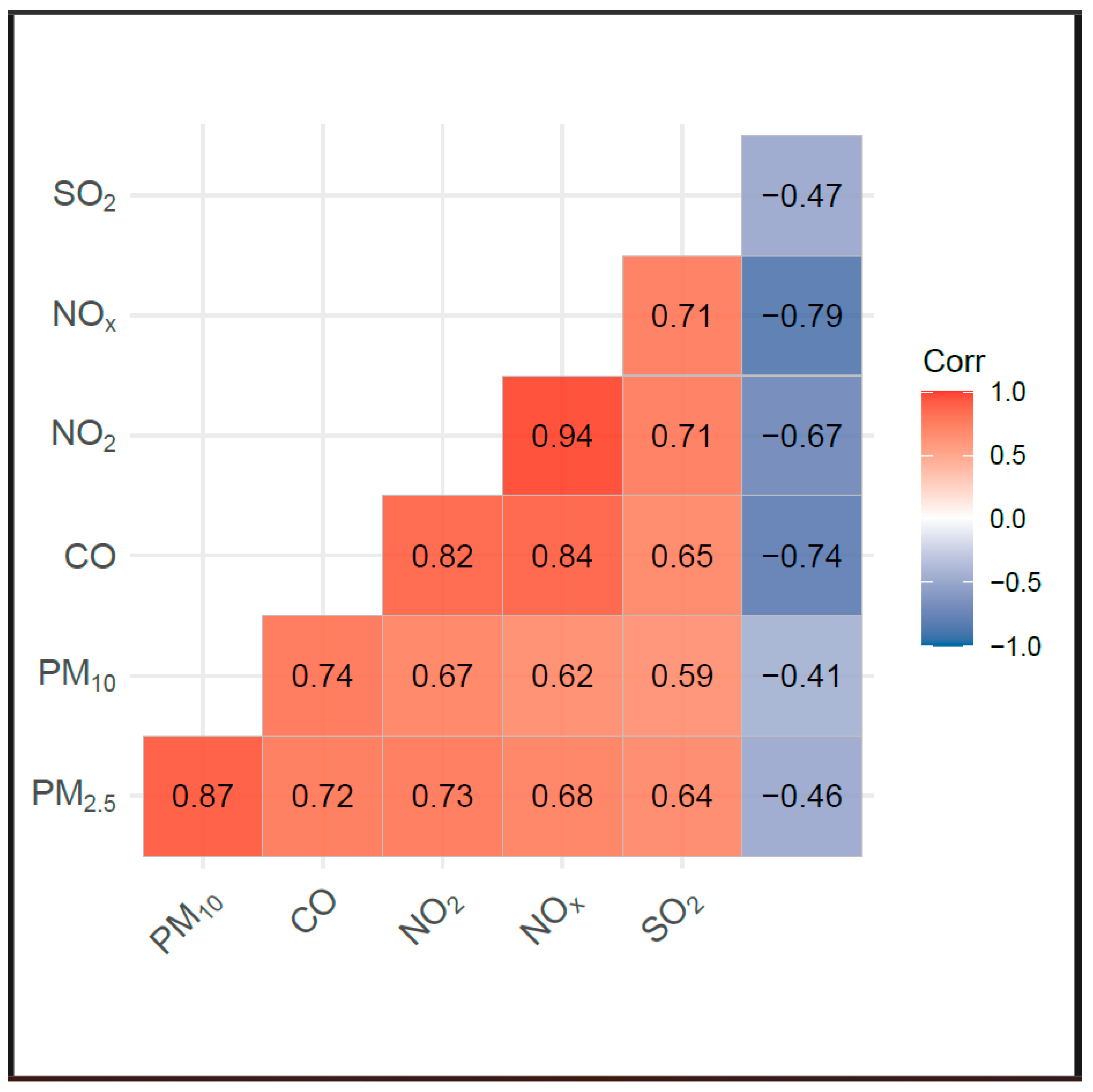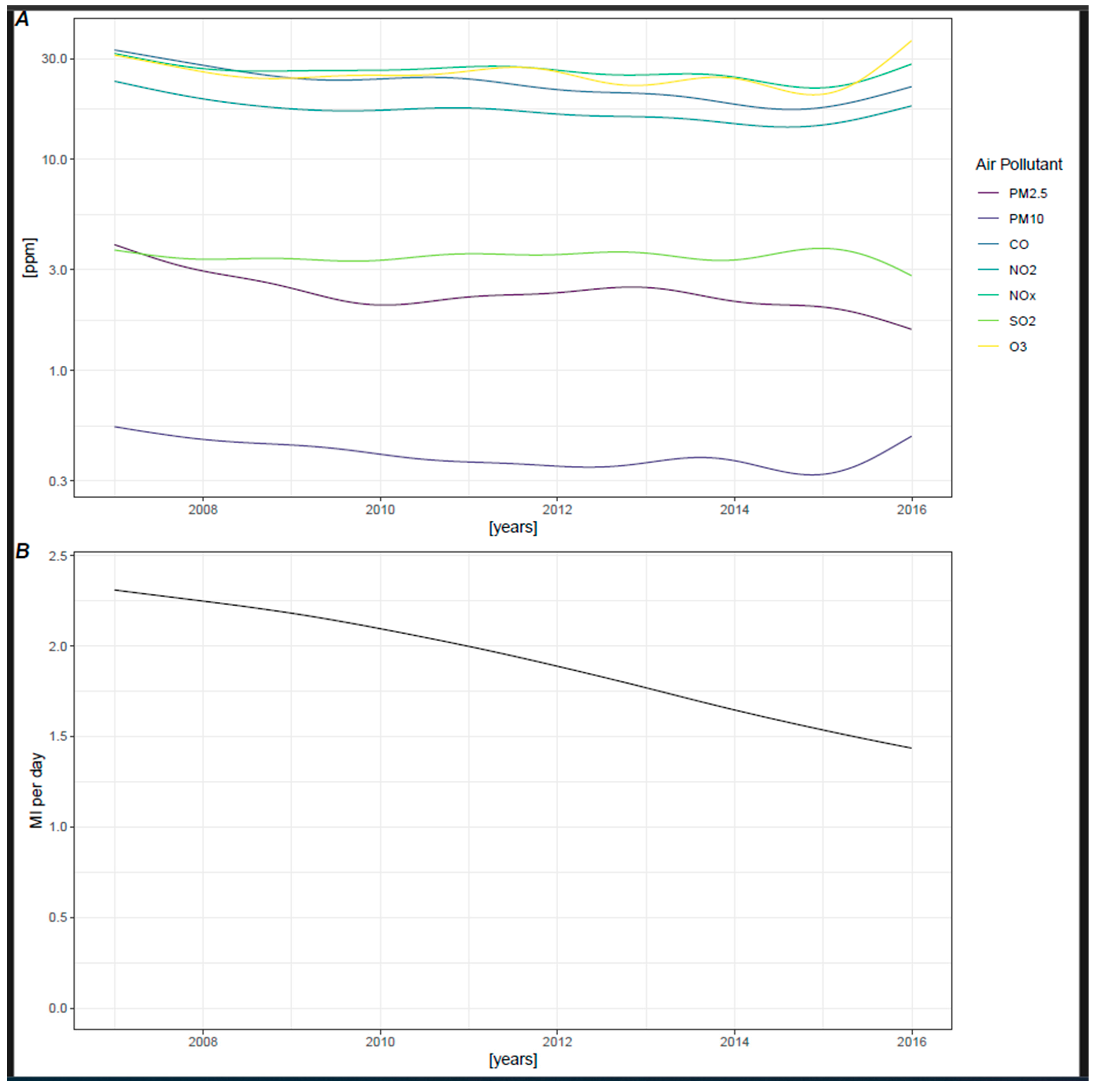Air Pollution and Myocardial Infarction—A New Smoker’s Paradox?
Abstract
1. Introduction
2. Methods
Statistical Analysis
3. Results
4. Discussion
Study Limitations
Supplementary Materials
Author Contributions
Funding
Institutional Review Board Statement
Informed Consent Statement
Data Availability Statement
Conflicts of Interest
References
- Du, Y.; Xu, X.; Chu, M.; Guo, Y.; Wang, J. Air particulate matter and cardiovascular disease: The epidemiological, biomedical and clinical evidence. J. Thorac. Dis. 2016, 8, E8–E19. [Google Scholar] [CrossRef] [PubMed]
- Li, R.; Ning, Z.; Cui, J.; Khalsa, B.; Ai, L.; Takabe, W.; Beebe, T.; Majumdar, R.; Sioutas, C.; Hsiai, T. Ultrafine particles from diesel engines induce vascular oxidative stress via JNK activation. Free Radic. Biol. Med. 2009, 46, 775–782. [Google Scholar] [CrossRef] [PubMed]
- Danesh Yazdi, M.; Wei, Y.; Di, Q.; Requia, W.J.; Shi, L.; Sabath, M.B.; Dominici, F.; Schwartz, J. The effect of long-term exposure to air pollution and seasonal temperature on hospital admissions with cardiovascular and respiratory disease in the United States: A difference-in-differences analysis. Sci. Total Environ. 2022, 843, 156855. [Google Scholar] [CrossRef] [PubMed]
- Bai, L.; Benmarhnia, T.; Chen, C.; Kwong, J.C.; Burnett, R.T.; van Donkelaar, A.; Martin, R.V.; Kim, J.; Kaufman, J.S.; Chen, H. Chronic Exposure to Fine Particulate Matter Increases Mortality Through Pathways of Metabolic and Cardiovascular Disease: Insights From a Large Mediation Analysis. J. Am. Heart Assoc. 2022, 11, e026660. [Google Scholar] [CrossRef]
- Choi, S.Y.; Rha, S.-W.; Cha, J.; Byun, J.K.; Choi, B.G.; Jeong, M.H. Korea Acute Myocardial Infraction Registry study group Association of air pollution and 1-year clinical outcomes of patients with acute myocardial infarction. PLoS ONE 2022, 17, e0272328. [Google Scholar] [CrossRef]
- Marchini, T.; Wolf, D.; Michel, N.A.; Mauler, M.; Dufner, B.; Hoppe, N.; Beckert, J.; Jäckel, M.; Magnani, N.; Duerschmied, D.; et al. Acute exposure to air pollution particulate matter aggravates experimental myocardial infarction in mice by potentiating cytokine secretion from lung macrophages. Basic Res. Cardiol. 2016, 111, 44. [Google Scholar] [CrossRef]
- Kilbo Edlund, K.; Sallsten, G.; Molnár, P.; Andersson, E.M.; Ögren, M.; Segersson, D.; Fagman, E.; Fagerberg, B.; Barregard, L.; Bergström, G.; et al. Long-term exposure to air pollution, coronary artery calcification, and carotid artery plaques in the population-based Swedish SCAPIS Gothenburg cohort. Environ. Res. 2022, 214, 113926. [Google Scholar] [CrossRef]
- Liu, Y.; Pan, J.; Fan, C.; Xu, R.; Wang, Y.; Xu, C.; Xie, S.; Zhang, H.; Cui, X.; Peng, Z.; et al. Short-Term Exposure to Ambient Air Pollution and Mortality From Myocardial Infarction. J. Am. Coll. Cardiol. 2021, 77, 271–281. [Google Scholar] [CrossRef]
- Ishii, M.; Seki, T.; Kaikita, K.; Sakamoto, K.; Nakai, M.; Sumita, Y.; Nishimura, K.; Miyamoto, Y.; Noguchi, T.; Yasuda, S.; et al. Association of short-term exposure to air pollution with myocardial infarction with and without obstructive coronary artery disease. Eur. J. Prev. Cardiol. 2021, 28, 1435–1444. [Google Scholar] [CrossRef]
- Wu, K.; Ho, H.C.; Su, H.; Huang, C.; Zheng, H.; Zhang, W.; Tao, J.; Hossain, M.Z.; Zhang, Y.; Hu, K.; et al. A systematic review and meta-analysis of intraday effects of ambient air pollution and temperature on cardiorespiratory morbidities: First few hours of exposure matters to life. EBioMedicine 2022, 86, 104327. [Google Scholar] [CrossRef]
- Mustafic, H.; Jabre, P.; Caussin, C.; Murad, M.H.; Escolano, S.; Tafflet, M.; Périer, M.-C.; Marijon, E.; Vernerey, D.; Empana, J.-P.; et al. Main air pollutants and myocardial infarction: A systematic review and meta-analysis. JAMA 2012, 307, 713–721. [Google Scholar] [CrossRef] [PubMed]
- Li, J.; Liu, C.; Cheng, Y.; Guo, S.; Sun, Q.; Kan, L.; Chen, R.; Kan, H.; Bai, H.; Cao, J. Association between ambient particulate matter air pollution and ST-elevation myocardial infarction: A case-crossover study in a Chinese city. Chemosphere 2019, 219, 724–729. [Google Scholar] [CrossRef] [PubMed]
- Chen, C.; Liu, X.; Wang, X.; Qu, W.; Li, W.; Dong, L. Effect of air pollution on hospitalization for acute exacerbation of chronic obstructive pulmonary disease, stroke, and myocardial infarction. Environ. Sci. Pollut. Res. Int. 2020, 27, 3384–3400. [Google Scholar] [CrossRef] [PubMed]
- Pan, H.-Y.; Cheung, S.-M.; Chen, F.-C.; Wu, K.-H.; Cheng, S.-Y.; Chuang, P.-C.; Cheng, F.-J. Short-Term Effects of Ambient Air Pollution on ST-Elevation Myocardial Infarction Events: Are There Potentially Susceptible Groups? Int. J. Environ. Res. Public Health 2019, 16, 3760. [Google Scholar] [CrossRef]
- Gennaro, G.; Brener, S.J.; Redfors, B.; Kirtane, A.J.; Généreux, P.; Maehara, A.; Neunteufl, T.; Metzger, D.C.; Mehran, R.; Gibson, C.M.; et al. Effect of Smoking on Infarct Size and Major Adverse Cardiac Events in Patients With Large Anterior ST-Elevation Myocardial Infarction (from the INFUSE-AMI Trial). Am. J. Cardiol. 2016, 118, 1097–1104. [Google Scholar] [CrossRef]
- Feistritzer, H.-J.; Eitel, I.; Jobs, A.; de Waha-Thiele, S.; Stiermaier, T.; Abdel-Wahab, M.; Lurz, P.; Reinstadler, S.J.; Reindl, M.; Klug, G.; et al. Impact of smoking on cardiac magnetic resonance infarct characteristics and clinical outcome in patients with non-ST-elevation myocardial infarction. Int. J. Cardiovasc. Imaging 2019, 35, 1079–1087. [Google Scholar] [CrossRef]
- De Luca, G.; Parodi, G.; Sciagrà, R.; Bellandi, B.; Comito, V.; Vergara, R.; Migliorini, A.; Valenti, R.; Antoniucci, D. Smoking and infarct size among STEMI patients undergoing primary angioplasty. Atherosclerosis 2014, 233, 145–148. [Google Scholar] [CrossRef]
- Redfors, B.; Furer, A.; Selker, H.P.; Thiele, H.; Patel, M.R.; Chen, S.; Udelson, J.E.; Ohman, E.M.; Eitel, I.; Granger, C.B.; et al. Effect of Smoking on Outcomes of Primary PCI in Patients With STEMI. J. Am. Coll. Cardiol. 2020, 75, 1743–1754. [Google Scholar] [CrossRef]
- Sun, Q.; Cao, B.; Jiang, Y.; Zhuang, J.; Zhang, C.; Jiang, B. Association between ambient particulate matter (PM2.5/PM10) and first incident ST-elevation myocardial infarction in Suzhou, China. Environ. Sci. Pollut. Res. 2022, 29, 62690–62697. [Google Scholar] [CrossRef]
- Lee, S.; Lee, W.; Lee, E.; Jeong, M.H.; Rha, S.-W.; Kim, C.-J.; Chae, S.C.; Kim, H.-S.; Gwon, H.-C.; Kim, H. Effects of Asian dust-derived particulate matter on ST-elevation myocardial infarction: Retrospective, time series study. BMC Public Health 2021, 21, 68. [Google Scholar] [CrossRef]
- Armstrong, B.G.; Gasparrini, A.; Tobias, A. Conditional Poisson models: A flexible alternative to conditional logistic case cross-over analysis. BMC Med. Res. Methodol. 2014, 14, 122. [Google Scholar] [CrossRef] [PubMed]
- Cohen, A.J.; Brauer, M.; Burnett, R.; Anderson, H.R.; Frostad, J.; Estep, K.; Balakrishnan, K.; Brunekreef, B.; Dandona, L.; Dandona, R.; et al. Estimates and 25-year trends of the global burden of disease attributable to ambient air pollution: An analysis of data from the Global Burden of Diseases Study 2015. Lancet 2017, 389, 1907–1918. [Google Scholar] [CrossRef] [PubMed]
- de Bont, J.; Jaganathan, S.; Dahlquist, M.; Persson, Å.; Stafoggia, M.; Ljungman, P. Ambient air pollution and cardiovascular diseases: An umbrella review of systematic reviews and meta-analyses. J. Intern. Med. 2022, 291, 779–800. [Google Scholar] [CrossRef] [PubMed]
- Woźniak, E.; Świstek, M.; Broncel, M.; Bukowska, B.; Gorzelak-Pabiś, P. The protective effects of empagliflozin on DNA oxidative changes in a model of vascular endothelial and smooth muscle cells damaged by oxidized cholesterol. Biomed. Pharmacother. 2024, 170, 116065. [Google Scholar] [CrossRef]
- von Lewinski, D.; Kolesnik, E.; Tripolt, N.J.; Pferschy, P.N.; Benedikt, M.; Wallner, M.; Alber, H.; Berger, R.; Lichtenauer, M.; Saely, C.H.; et al. Empagliflozin in acute myocardial infarction: The EMMY trial. Eur. Heart J. 2022, 43, 4421–4432. [Google Scholar] [CrossRef]
- Sourij, C.; Aziz, F.; Tripolt, N.J.; Siller-Matula, J.; Pferschy, P.N.; Kolesnik, E.; Wallner, M.; Eyileten, C.; Postula, M.; Oulhaj, A.; et al. Effects of empagliflozin in women and men with acute myocardial infarction: An analysis from the EMMY trial. Hell. J. Cardiol. 2024, 75, 3–8. [Google Scholar] [CrossRef]
- Sourij, C.; Oulhaj, A.; Aziz, F.; Tripolt, N.J.; Aberer, F.; Pferschy, P.N.; Postula, M.; Drexel, H.; Benedikt, M.; Kolesnik, E.; et al. Impact of glycaemic status on the cardiac effects of empagliflozin when initiated immediately after myocardial infarction: A post-hoc analysis of the EMMY trial. Diabetes Obes. Metab. 2024, 26, 1971–1975. [Google Scholar] [CrossRef]
- Benedikt, M.; Aziz, F.; Fröschl, T.; Strohhofer, C.; Kolesnik, E.; Tripolt, N.; Pferschy, P.; Wallner, M.; Bugger, H.; Zirlik, A.; et al. Impact of baseline ECG characteristics on changes in cardiac biomarkers and echocardiographic metrices after acute myocardial infarction treated with Empagliflozin. Sci. Rep. 2024, 14, 15083. [Google Scholar] [CrossRef]
- von Lewinski, D.; Kolesnik, E.; Aziz, F.; Benedikt, M.; Tripolt, N.J.; Wallner, M.; Pferschy, P.N.; von Lewinski, F.; Schwegel, N.; Holman, R.R.; et al. Timing of SGLT2i initiation after acute myocardial infarction. Cardiovasc. Diabetol. 2023, 22, 269. [Google Scholar] [CrossRef]
- James, S.; Erlinge, D.; Storey, R.F.; McGuire, D.K.; de Belder, M.; Eriksson, N.; Andersen, K.; Austin, D.; Arefalk, G.; Carrick, D.; et al. Dapagliflozin in Myocardial Infarction without Diabetes or Heart Failure. NEJM Evid. 2024, 3, EVIDoa2300286. [Google Scholar] [CrossRef]
- Butler, J.; Jones, W.S.; Udell, J.A.; Anker, S.D.; Petrie, M.C.; Harrington, J.; Mattheus, M.; Zwiener, I.; Amir, O.; Bahit, M.C. Empagliflozin after Acute Myocardial Infarction. N. Engl. J. Med. 2024, 390, 1455–1466. [Google Scholar] [CrossRef] [PubMed]
- Karakasis, P.; Fragakis, N.; Kouskouras, K.; Karamitsos, T.; Patoulias, D.; Rizzo, M. Sodium-Glucose Cotransporter-2 Inhibitors in Patients With Acute Coronary Syndrome: A Modern Cinderella? Clin. Ther. 2024, 46, 841–850. [Google Scholar] [CrossRef] [PubMed]
- Vineis, P.; Robinson, O.; Chadeau-Hyam, M.; Dehghan, A.; Mudway, I.; Dagnino, S. What is new in the exposome? Environ. Int. 2020, 143, 105887. [Google Scholar] [CrossRef] [PubMed]




| Risk Factors | n | Sex (Male) | Sex (Female) | Age (IQR) | BMI (IQR) | STEMI | NSTE-ACS |
|---|---|---|---|---|---|---|---|
| All | 12,581 | 8192 (65.1%) | 4389 (34.9%) | 68 (58–76) | 27 (24.4–30.1) | 4217 (33.5%) | 8364 (66.5%) |
| COPD | 1170 | 796 (68%) | 374 (32%) | 71 (64–78) | 27.3 (24.2–30.2) | 254 (21.7%) | 916 (78.3%) |
| Diabetes | 3111 | 1921 (61.7%) | 1190 (38.3%) | 71 (63–77) | 28.4 (25.5–31.7) | 862 (27.7%) | 2249 (72.3%) |
| HFrEF | 3010 | 1862 (61.9%) | 1148 (38.1%) | 73 (64–80) | 26.2 (23.9–29.1) | 1080 (35.9%) | 1930 (64.1%) |
| Hypertension | 9235 | 5837 (63.2%) | 3398 (36.8%) | 69 (60–77) | 27.4 (24.8–30.5) | 2724 (29.5%) | 6511 (70.5%) |
| Smoker | 665 | 516 (77.6%) | 149 (22.4%) | 56 (49–64) | 27.2 (24.4–30.4) | 324 (48.7%) | 341 (51.3%) |
| NSTE-ACS | 8364 | 5244 (62.7%) | 3120 (37.3%) | 69 (60–77) | 27.1 (24.4–30.1) | 0 (0%) | 8364 (100%) |
| STEMI | 4217 | 2948 (69.9%) | 1269 (30.1%) | 65 (54–75) | 26.8 (24.4–29.7) | 4217 (100%) | 0 (0%) |
| No Dm, HTN, HFrEF | 1181 | 877 (74.3%) | 304 (25.7%) | 58 (50–68) | 25.9 (23.8–28.7) | 551 (46.7%) | 630 (53.3%) |
| DM + HTN + HFrEF | 848 | 513 (60.5%) | 335 (39.5%) | 74 (67–80) | 27.7 (25–31.1) | 240 (28.3%) | 608 (71.7%) |
| Disease | Diseased | Not Diseased | Pollutant | Coefficient | Std.Err | Confint.Rel | p-Value |
|---|---|---|---|---|---|---|---|
| COPD | 1170 | 11,411 | CO | −0.032 | 0.066 | 0.969 (0.851–1.103) | 0.63 |
| NO2 | 0.005 | 0.079 | 1.005 (0.861–1.173) | 0.95 | |||
| NOx | 0.042 | 0.068 | 1.042 (0.912–1.192) | 0.54 | |||
| O3 | −0.184 | 0.081 | 0.832 (0.71–0.975) | 0.023 | |||
| PM10 | 0.025 | 0.071 | 1.025 (0.892–1.177) | 0.73 | |||
| PM2.5 | 0.076 | 0.072 | 1.078 (0.936–1.243) | 0.3 | |||
| SO2 | −0.046 | 0.07 | 0.955 (0.834–1.095) | 0.51 | |||
| Diabetes | 3111 | 9470 | CO | 0.047 | 0.045 | 1.048 (0.96–1.144) | 0.3 |
| NO2 | −0.015 | 0.052 | 0.986 (0.889–1.092) | 0.78 | |||
| NOx | 0.044 | 0.046 | 1.045 (0.955–1.145) | 0.34 | |||
| O3 | 0.035 | 0.054 | 1.036 (0.932–1.151) | 0.51 | |||
| PM10 | 0.027 | 0.047 | 1.027 (0.937–1.126) | 0.57 | |||
| PM2.5 | 0.061 | 0.048 | 1.063 (0.967–1.168) | 0.21 | |||
| SO2 | 0.036 | 0.047 | 1.037 (0.946–1.137) | 0.44 | |||
| Dm + HTN + HFrEF | 848 | 1181 | CO | 0.134 | 0.097 | 1.143 (0.946–1.382) | 0.17 |
| NO2 | −0.09 | 0.113 | 0.914 (0.733–1.141) | 0.43 | |||
| NOx | 0.112 | 0.099 | 1.118 (0.922–1.357) | 0.26 | |||
| O3 | 0.237 | 0.118 | 1.268 (1.007–1.596) | 0.044 | |||
| PM10 | 0.006 | 0.101 | 1.006 (0.826–1.226) | 0.95 | |||
| PM2.5 | 0.084 | 0.104 | 1.087 (0.887–1.333) | 0.42 | |||
| SO2 | −0.002 | 0.104 | 0.998 (0.813–1.224) | 0.98 | |||
| HFrEF | 3010 | 4894 | CO | 0.033 | 0.051 | 1.034 (0.936–1.142) | 0.51 |
| NO2 | −0.07 | 0.059 | 0.932 (0.83–1.048) | 0.24 | |||
| NOx | 0.012 | 0.052 | 1.012 (0.915–1.121) | 0.81 | |||
| O3 | −0.049 | 0.06 | 0.952 (0.846–1.072) | 0.42 | |||
| PM10 | −0.009 | 0.054 | 0.991 (0.892–1.102) | 0.87 | |||
| PM2.5 | 0.02 | 0.055 | 1.02 (0.915–1.137) | 0.72 | |||
| SO2 | 0.078 | 0.054 | 1.081 (0.972–1.202) | 0.15 | |||
| Hypertension | 9235 | 3346 | CO | 0.025 | 0.044 | 1.025 (0.941–1.117) | 0.57 |
| NO2 | 0.018 | 0.052 | 1.018 (0.92–1.127) | 0.73 | |||
| NOx | 0.013 | 0.045 | 1.013 (0.928–1.107) | 0.77 | |||
| O3 | 0.028 | 0.053 | 1.028 (0.927–1.141) | 0.59 | |||
| PM10 | −0.038 | 0.046 | 0.963 (0.879–1.054) | 0.41 | |||
| PM2.5 | 0.017 | 0.048 | 1.017 (0.926–1.117) | 0.72 | |||
| SO2 | −0.062 | 0.046 | 0.94 (0.86–1.028) | 0.18 | |||
| Smoker | 665 | 7677 | CO | −0.445 | 0.111 | 0.641 (0.515–0.797) | 0.000066 |
| NO2 | −0.145 | 0.119 | 0.865 (0.685–1.092) | 0.22 | |||
| NOx | −0.253 | 0.102 | 0.777 (0.636–0.948) | 0.013 | |||
| O3 | 0.272 | 0.105 | 1.313 (1.068–1.612) | 0.0096 | |||
| PM10 | −0.674 | 0.139 | 0.51 (0.388–0.669) | 0.0000012 | |||
| PM2.5 | −0.408 | 0.123 | 0.665 (0.522–0.847) | 0.00096 | |||
| SO2 | −0.635 | 0.13 | 0.53 (0.411–0.683) | 0.000001 | |||
| STEMI | 4217 | 8364 | CO | −0.053 | 0.042 | 0.948 (0.874–1.029) | 0.2 |
| NO2 | −0.129 | 0.049 | 0.879 (0.799–0.967) | 0.0082 | |||
| NOx | −0.096 | 0.042 | 0.909 (0.836–0.988) | 0.024 | |||
| O3 | −0.038 | 0.049 | 0.963 (0.874–1.06) | 0.44 | |||
| PM10 | −0.032 | 0.044 | 0.968 (0.888–1.055) | 0.46 | |||
| PM2.5 | −0.052 | 0.045 | 0.949 (0.869–1.037) | 0.25 | |||
| SO2 | −0.057 | 0.044 | 0.945 (0.868–1.029) | 0.19 |
Disclaimer/Publisher’s Note: The statements, opinions and data contained in all publications are solely those of the individual author(s) and contributor(s) and not of MDPI and/or the editor(s). MDPI and/or the editor(s) disclaim responsibility for any injury to people or property resulting from any ideas, methods, instructions or products referred to in the content. |
© 2024 by the authors. Licensee MDPI, Basel, Switzerland. This article is an open access article distributed under the terms and conditions of the Creative Commons Attribution (CC BY) license (https://creativecommons.org/licenses/by/4.0/).
Share and Cite
von Lewinski, F.; Quehenberger, F.; Sacherer, M.; Taucher, V.; Strohhofer, C.; Ablasser, K.; Verheyen, N.; Sourij, C.; Kainz, A.; Wünsch, G.; et al. Air Pollution and Myocardial Infarction—A New Smoker’s Paradox? J. Clin. Med. 2024, 13, 7324. https://doi.org/10.3390/jcm13237324
von Lewinski F, Quehenberger F, Sacherer M, Taucher V, Strohhofer C, Ablasser K, Verheyen N, Sourij C, Kainz A, Wünsch G, et al. Air Pollution and Myocardial Infarction—A New Smoker’s Paradox? Journal of Clinical Medicine. 2024; 13(23):7324. https://doi.org/10.3390/jcm13237324
Chicago/Turabian Stylevon Lewinski, Friederike, Franz Quehenberger, Michael Sacherer, Valentin Taucher, Christoph Strohhofer, Klemens Ablasser, Nicolas Verheyen, Caren Sourij, Andreas Kainz, Gerit Wünsch, and et al. 2024. "Air Pollution and Myocardial Infarction—A New Smoker’s Paradox?" Journal of Clinical Medicine 13, no. 23: 7324. https://doi.org/10.3390/jcm13237324
APA Stylevon Lewinski, F., Quehenberger, F., Sacherer, M., Taucher, V., Strohhofer, C., Ablasser, K., Verheyen, N., Sourij, C., Kainz, A., Wünsch, G., Berghold, A., Berghaus, T. M., Kanoun Schnur, S. S., Zirlik, A., & von Lewinski, D. (2024). Air Pollution and Myocardial Infarction—A New Smoker’s Paradox? Journal of Clinical Medicine, 13(23), 7324. https://doi.org/10.3390/jcm13237324







